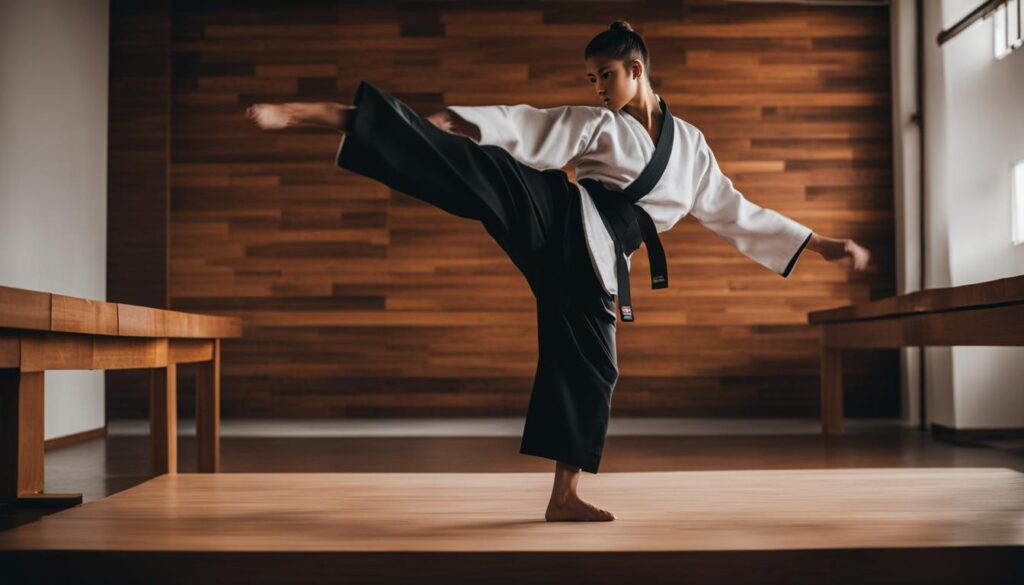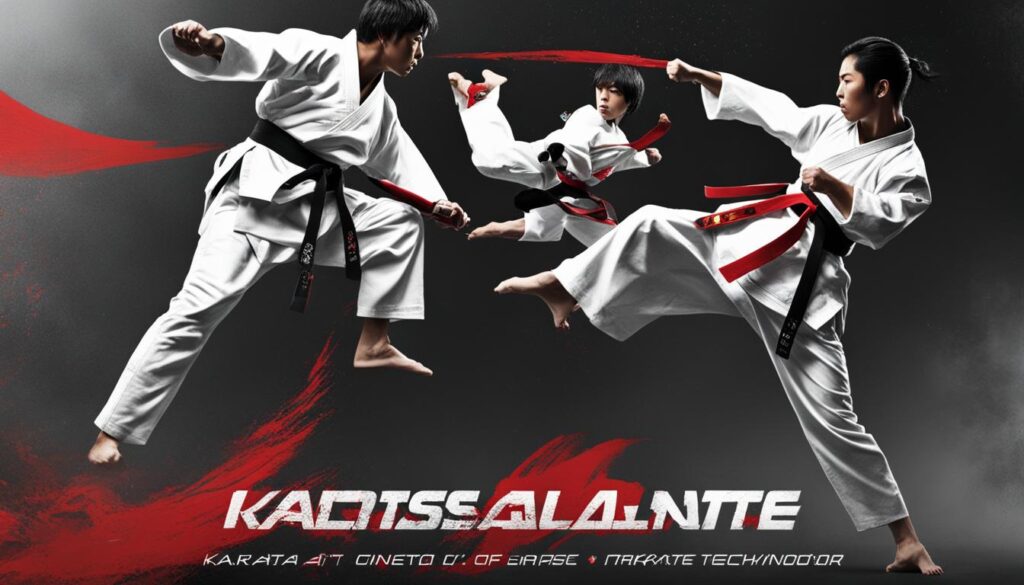Practicing martial arts can have numerous physical and mental health benefits. Whether you’re looking to improve your self-defense skills, get a full-body aerobic workout, build muscle, or enhance your balance, martial arts can provide a holistic approach to fitness and well-being. Two popular martial arts forms that offer these benefits are Taekwondo and Karate.
Taekwondo and Karate are distinct martial arts styles with unique techniques and philosophies. If you’re wondering which one is better suited to your needs, let’s delve into the similarities and differences between these two disciplines to help you make an informed choice.
Key Takeaways:
- Taekwondo and Karate offer physical and mental health benefits.
- Both martial arts start with fundamental rules and basic moves.
- Karate emphasizes hand techniques and uses kicks as backup.
- Taekwondo involves more kicking and emphasizes powerful kicks.
- Karate originated in Okinawa, while Taekwondo has ancient roots in Korea.
Similarities between Taekwondo and Karate
When comparing Taekwondo and Karate, it becomes evident that there are several similarities between these two martial arts forms. Both disciplines start by teaching beginners the fundamental rules and basic moves necessary to establish a strong foundation. In both Taekwondo and Karate, practitioners learn a variety of stances, punches, kicks, and effective blocking techniques.
Although the techniques may differ slightly between the two, the core principles remain the same. Both Taekwondo and Karate prioritize discipline, precision, and control. These martial arts forms train individuals to become physically and mentally strong while developing self-defense skills.
However, it’s important to clarify that holding stances for an extended period of time is not beneficial in an actual fight. The purpose of holding stances is to train the body to maintain proper form and technique, allowing practitioners to execute moves with accuracy and control in a real combat situation.
Below is a table that highlights the key similarities between Taekwondo and Karate:
| Taekwondo | Karate |
|---|---|
| Focuses on kicks | Emphasizes hand techniques |
| Involves a variety of spinning and jumping kicks | Utilizes shuto uchi, or karate chop, and various kicking moves |
| Teaches different stances, punches, and blocking techniques | Teaches stances, punches, and blocking techniques |
Continue reading to explore the unique techniques of Karate or skip ahead to discover the techniques of Taekwondo.
The Techniques of Karate
Karate is a martial art that places a strong emphasis on hand techniques while utilizing kicks as backup. It is well-known for its signature move, the shuto uchi, or karate chop, which is executed with a swift, powerful strike. Karate practitioners also learn various kicking moves, such as front kicks, side kicks, and roundhouse kicks, to complement their hand techniques. The combination of hand and kicking techniques enables karate practitioners to engage in versatile combat strategies.
Through the practice of karate, individuals can experience numerous benefits for both their physical and mental well-being. The demanding nature of karate training not only builds strength and endurance but also cultivates mental fortitude and discipline. The constant repetition and refinement of techniques help practitioners develop focus, concentration, and self-control.
Furthermore, karate training provides a holistic approach to personal development. It fosters resilience, enhances self-confidence, and reinforces humility. The rigorous training sessions instill a sense of dedication and motivation, enabling karate practitioners to overcome challenges both inside and outside the dojo.
Overall, the techniques of karate offer individuals a rewarding martial arts experience that encompasses physical fitness, mental strength, and self-discipline.

Comparison of Taekwondo and Karate Techniques
| Techniques | Taekwondo | Karate |
|---|---|---|
| Primary Emphasis | Kicking Techniques | Hand Techniques |
| Backup Techniques | Hand Techniques | Kicking Techniques |
| Signature Moves | Spinning and Jumping Kicks | Shuto Uchi (Karate Chop) |
| Training Focus | Fast and Powerful Kicks | Muscular Strength and Stamina |
The Techniques of Taekwondo
Taekwondo, like Karate, is a martial art that offers numerous benefits for practitioners. However, Taekwondo has its own distinct techniques that set it apart from Karate. One of the key differences is the heavy emphasis on kicks in Taekwondo, making it an excellent choice for those who want to develop exceptional kicking skills.
In Taekwondo, practitioners learn a wide range of kicks, from basic kicks to more advanced spinning and jumping kicks. This not only enhances physical fitness but also improves flexibility, coordination, and agility. The ability to execute powerful kicks with precision is a defining characteristic of Taekwondo.
Moreover, Taekwondo utilizes a unique leg stance that enables practitioners to generate fast and powerful kicks. This technique combines proper body positioning and weight distribution to optimize the speed and strength of each kick. By mastering this stance, Taekwondo practitioners can deliver swift and impactful kicks.
The techniques of Taekwondo are not only focused on physical strength and agility but also on mental discipline. Through dedicated training, practitioners develop mental focus, perseverance, and self-control, which are essential in both martial arts and everyday life.
Ultimately, when choosing between Taekwondo and Karate, it is crucial to consider your personal preferences, goals, and what you hope to achieve from your martial arts practice. If you have a strong inclination towards kicking techniques, want to improve your flexibility and agility, and value the mental discipline that comes with it, Taekwondo may be the ideal choice for you.
History of Karate and Taekwondo
Karate and Taekwondo have rich histories that span centuries and continents. Understanding the origins of these martial arts forms can provide valuable insights into their self-defense and fitness benefits.
“Karate originated around 500 years ago on the Japanese island of Okinawa. It was developed as a form of self-defense when weapons were banned to prevent war.”
Karate was born out of necessity during a time of conflict. The people of Okinawa faced a ban on weapons, leading them to develop unarmed combat techniques to protect themselves and their communities. Over time, these techniques evolved into what we recognize today as Karate. The focus of Karate is on hand techniques and balanced movements, combining punches, strikes, kicks, and blocks for effective self-defense.
“Taekwondo has ancient roots dating back to 50 B.C.E. in Korea and was practiced to defend oneself using kicks and punches.”
Taekwondo, on the other hand, traces its roots back to ancient Korea. It was originally practiced as a means of self-defense against various threats and conflicts. Taekwondo utilizes a wide range of kicks and punches, with a heavy emphasis on powerful kicks. The use of dynamic and explosive kicks sets Taekwondo apart and shapes its distinctive style.
Today, both Karate and Taekwondo have become global martial arts, recognized for their self-defense applications and fitness benefits. They continue to evolve and be practiced by individuals around the world.

Competitions in Karate and Taekwondo
Both Karate and Taekwondo have specific rules and guidelines for competitions. Competing in these martial arts forms not only allows practitioners to showcase their skills but also helps in the development of discipline, focus, and self-improvement. Let’s take a closer look at the competitions in Karate and Taekwondo.
Karate Competitions:
In Karate competitions, participants are awarded points based on their punches and kicks, following different scoring criteria. These competitions provide a platform for practitioners to demonstrate their precision, speed, and power. Judges assess the quality and effectiveness of each technique, ensuring fairness and accuracy in the results.
Taekwondo Competitions:
Taekwondo competitions give higher points for kicks, reflecting the art’s focus on kicking techniques. Practitioners showcase their agility, flexibility, and precise execution of kicks. These competitions promote healthy competition, discipline, and sportsmanship, fostering personal growth and self-confidence within the Taekwondo community.
Competitions in both Karate and Taekwondo offer participants the opportunity to test their skills, compete against others, and advance through different levels of competition. It’s a chance for practitioners to refine their techniques, challenge themselves mentally and physically, and achieve personal goals.
Comparison of Karate and Taekwondo Competitions
| Karate Competitions | Taekwondo Competitions |
|---|---|
| Points awarded for punches and kicks | Higher points given for kicks |
| Focus on precision, speed, and power | Emphasis on agility, flexibility, and kicking techniques |
| Judges assess technique quality and effectiveness | Practitioners showcase precise execution of kicks |
| Promote discipline, fairness, and sportsmanship | Foster personal growth and self-confidence |
Conclusion
When it comes to choosing between Taekwondo and Karate, it ultimately boils down to individual preferences and goals. Both martial arts forms offer a comprehensive full-body workout, teach discipline, and develop self-defense skills. However, there are distinct differences in their techniques and focus.
Karate places greater emphasis on hand techniques and balanced movements. It is known for its shuto uchi, or karate chop, and incorporates various types of kicks. Karate practitioners focus on building mental strength and stamina, as well as mastering hand techniques and combinations.
On the other hand, Taekwondo is all about powerful kicks. It involves a wide range of kicking techniques, including spinning and jumping kicks. Taekwondo utilizes a different leg stance that enables practitioners to deliver fast and impactful kicks.
For those just starting their martial arts journey, it is recommended to try classes in both Taekwondo and Karate to determine which style resonates best with their preferences and goals. Understanding that Karate focuses more on hand techniques and balance while Taekwondo emphasizes powerful kicks can help individuals make an informed decision.
Ultimately, the best choice is the one that aligns with individual fitness and self-defense goals. Whether it’s the balanced movements and hand techniques of Karate or the explosive kicks of Taekwondo, both martial arts forms provide a holistic approach to physical and mental well-being.
FAQ
What is the difference between Taekwondo and Karate?
Taekwondo emphasizes powerful kicks and utilizes a different leg stance, while Karate focuses on hand techniques and balanced movements.
Which martial art form is better for self-defense, Taekwondo or Karate?
Both Taekwondo and Karate teach self-defense skills, but Taekwondo’s emphasis on kicks can be advantageous in certain situations.
Are Taekwondo and Karate good for fitness?
Yes, both Taekwondo and Karate provide a full-body aerobic workout, help build muscle, and improve balance.
What are the benefits of practicing Taekwondo and Karate?
Practicing Taekwondo and Karate can enhance mental strength, discipline, self-confidence, and promote overall physical well-being.
How do Taekwondo and Karate competitions work?
In Karate competitions, points are awarded for punches and kicks, while Taekwondo competitions give higher points to kicks.
Can beginners try both Taekwondo and Karate before deciding?
Yes, beginners can take classes in both styles to determine which one suits them best.
